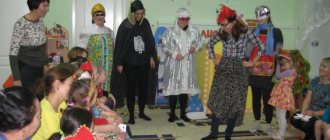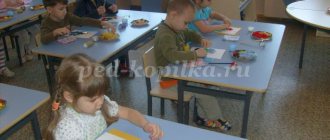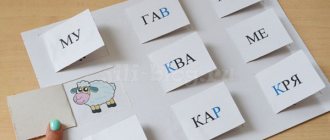Card index of games based on fairy tales
Progress of the game:
A fairy tale is chosen for adults (this may be a fairy tale that is currently being studied). The presenter takes one of the heroes of the fairy tale and describes him: he tells how he looks, good or evil, big or small, what he does during the fairy tale, etc. After that, he asks the children to repeat what he said.
Then the presenter takes another figurine and asks the children to take turns describing the hero and make sure that the descriptions are not repeated.
If this does not work, the presenter asks leading questions: for example, what is the grandfather wearing; is he old or young; what he does, etc. For correct answers, the child receives a token. The one who gives the most answers wins.
"Find by silhouette."
Purpose of the game: Development of speech, visual thinking, attention, figurative memory.
Material: figures of heroes from one fairy tale are used (“Turnip”, “Teremok”, “Kolobok”, “Hare and Fox (Zayushkina’s hut)”, etc.). You can use figurines of fairy-tale characters from the theater on flannelgraph.
Progress of the game:
The presenter asks the children to look at the figures from all sides. Next, he explains what a silhouette is and asks the children to trace the silhouette of the figure with their finger, and then with a pencil.
The presenter lays out the figures on the reverse side and asks them to find fairy tale characters and objects.
“Show me the same.”
Purpose of the game: Expand vocabulary. Teach children mental operations: comparison, generalization, logical thinking. Develop imagination, be able to classify objects according to different criteria.
Material: figurines of fairy tale characters from the theater on flannelgraph; pictures with plots of the chosen fairy tale.
Progress of the game.
The presenter talks about how there are identical objects, body parts in different people, animals, etc., and asks the children to show the same things.
Then he asks to answer his questions and show the same on the figures. For example, who has tails, who is dressed in skirts, how are grandfather, grandmother, granddaughter (they walk on their feet, people) similar, how are bugs, cats, mice (animals) similar, etc.
“Color according to the description.”
Purpose of the game: development of speech, the ability to listen to others, clearly express your thoughts; consolidation of the concept of “silhouette”; development of observation, imaginative thinking and imagination.
Material: figurines of fairy tale characters from the theater on flannelgraph; pictures with scenes from the game “Collect and tell a fairy tale”, the selected fairy tale; riddles for fairy tale heroes; colored pencils, paper.
Progress of the game.
The presenter tells the children a fairy tale and lays out supporting pictures with the plots of the fairy tale. Then, together with the children, he selects figurines of fairy tale heroes.
When the figures are in front of the children, an adult reads a riddle about one of the heroes from a card. Children must guess who we are talking about. The one who guessed first becomes the storyteller.
Didactic games based on Pushkin's fairy tales
1. “Goldfish” Goal: to improve the skills of composing, reading and analyzing sentences. An image of a goldfish with large removable scales. On the back of the scales are written the words: gold, fish, lives, in the ocean. - This golden fish, not an ordinary one, swam to us and brought words from which we need to make a sentence.
2. “Encryptions” Goal: improving the skills of sound analysis and word synthesis. On the typesetting canvas there are pictures with images of an old man, an old woman, and servants. – Look at the sound diagrams and place them under the corresponding pictures.
3. “Say the opposite” Goal: replenish the active vocabulary with adjectives with the opposite meaning. Ball game. - The old man is kind, and the old woman... (evil). - The old woman is obstinate, and the old man... (submissive). - At first the sea is calm, and then... (stormy). - The dugout was old, but the tower ... (new). - The old man’s clothes were poor, and the noblewoman’s... (rich). - The dugout was low, and the tower ... (high).
4. “In the blue sea-ocean” Goal: improving the grammatical structure of speech (prepositional-case constructions). The typesetting canvas displays flat images of stones, seaweed, shells and a goldfish. - The goldfish - the mistress of the sea - lives in the blue sea-ocean. Tell me what she does? (A goldfish swam out of a shell. A goldfish swam behind a stone. A goldfish swam out from behind a stone. A goldfish swam through a thicket of algae.)
5. “Family of words” Goal: enriching expressive speech with words of the same root, improving word formation skills. Ball game. – We will try to form words from one family with the word fish. – What do you call a very big fish? (fish) - What is a pie with fish called? (fisherman) - What is the name of the process of catching fish? (fishing) - What do you call a person who fishes? (fisherman) - Is it different? (fisherman) - If the old man is a fisherman, then what can you call his old woman? (fisherman) - What was the old man doing at sea? (fishing) - What do you call fish soup? (fish)
6. “Who is missing?” Goal: development of dialogic speech, visual attention, perception, memory, automation of correct pronunciation and differentiation in free speech activity of all previously delivered sounds. The typesetting canvas contains images of fairy-tale characters. Children close their eyes, and the teacher removes one character at a time. -Who is missing?
7. “Sound leapfrog” Goal: development of phonemic concepts, skills of sound analysis and synthesis. Ball game. – The names of which of the characters in “The Tale of Tsar Saltan...” end with a hard consonant sound N? (Saltan, Guidon) - Which fairy tale characters have a hard consonant sound X in their names? (weaver, cook, Babarikha) - Which character’s name contains two voiced hard consonants R? (Chernomor) – Which fairy tale character’s name begins with a soft consonant sound L? (Swan)
8. “Choose a scheme” Goal: development of skills in sound analysis and word synthesis. On the table there are cards with diagrams, on a typesetting canvas there are pictures with images of heroes of Pushkin’s fairy tales. Determine which scheme is suitable for the hero’s name. – Who do you see in the pictures? – What sound scheme is suitable? Why?
9. “Remember the fairy tale” Goal: development of memory, dexterity. Ball game. – I will throw the ball and ask a question. You will catch the ball and answer my question, while throwing the ball to me. – Who and in which fairy tale by Pushkin sang the song “In the garden, in the vegetable garden”? – Which of the heroes and in which fairy tale “the moon shines under the scythe”? – In what fairy tale do thirty-three heroes come ashore and what is their uncle’s name? – In which fairy tale did the main character turn into insects and which ones?
10. “Create captions for pictures” Goal: development of visual attention, perception, memory, improvement of reading skills, syntactic side of speech. On the table are illustrations to Pushkin's fairy tales and cards with words. You need to determine what work each of these illustrations was made for, and then use these words to create the name of the work under the picture. – Look at the illustrations and words. You need to determine what work each of these illustrations was made for, and then use these words to create the name of the work under the picture.
11. “Who is faster?” Goal: development of visual attention, perception, memory. Children take pictures out of the bag and name which work of Pushkin they correspond to. – Look at the pictures and name which work of Pushkin they correspond to.
12. “Compose and read words” Goal: improve the skill of composing and reading words. On the table in front of the children are cards with syllables. You need to compose and read the names of the heroes of Pushkin's fairy tales. – Make up and read the names of the heroes of Pushkin’s fairy tales.
Quest journey through Chukovsky’s fairy tales - “Telephone”, “Fedorino’s grief”, “Fly-Tsokotukha”, “Moidodyr”
Quest journey through Chukovsky’s fairy tales - “Telephone”, “Fedorino’s Mountain”, “Tsokotukha Fly”, “Moidodyr”
The goal of this fun quest is to introduce children to Chukovsky’s fairy tales and develop their desire to read. Select a few of the most popular and recognizable fairy tales for the game, and build your quest based on them.
Quest journey through Chukovsky’s fairy tales - “Telephone”, “Fedorino’s grief”, “Fly-Tsokotukha”, “Moidodyr”:
First location: “Telephone”
Choose a room without windows, or simply curtain the windows tightly, try to create twilight so that it is difficult to distinguish objects. Invite the children to find an important object in a dark room - a telephone. Tell me what to look for in a riddle.
Sound out its name with a riddle: We have a miracle of technology, the apparatus is top class! He transmits his voice through the tube. Dial the number boldly, chat with a friend or acquaintance. Voices and sounds in it, I really need... (Answer: telephone.)
And to make it interesting for children, treat the outline of the phone with paint that reacts to light. Give them flashlights and let them find the item they need. When he finds it, offer to voice the name of the poetic tale and reproduce at least a small part.
For example, the very beginning: My phone rang. - Who's talking? - Elephant. - Where? - From a camel. - What do you need? - Chocolate. - For whom? - For my son.
Second location “Fedorino Mountain”
Place several tables in the room - their number depends on the number of participants. Place dishes on the tables - plastic ones can be used. These can be plates, glasses, knives, forks, spoons. Arrange the dishes mixed with office supplies. Invite the children to quickly clean up the tables. Specify that all office supplies should be neatly folded in a drawer, and the dishes should be packaged - spoons to spoons, plates to plates, and so on. At the end, ask again to say the name of the fairy tale and read some of the parts
The correct answer is “Fedorino’s grief”: The sieve gallops through the fields, and the trough through the meadows. The broom followed the shovel along the street. Axes, axes, just pouring down from the mountain. The goat got scared, widened her eyes: “What is it?” Why? I don't understand anything.
Third location “Tsokotukha Fly”
Third location “Tsokotukha Fly”
To complete this stage of the quest you will need several large cans of cereal. Hide notes with riddles in the cereal. Guess will help participants guess the name of the fairy tale. Prepare containers in advance into which you can pour the cereal. Yes, and let each team independently decide which can to open first. One of them will immediately have the correct answer, which means this team will be able to move forward faster than others. The rest of the riddles should be simply suggestive.
Examples of riddles: I bought a samovar, and a mosquito saved her. (Fly Tsokotukha.)
I’m very annoying, but in a poem, by the way, I’ll tell you without embellishment: A mosquito saved my life. (Fly Tsokotukha.)
The people are having fun - The fly is getting married to the dashing, daring Young... (Mosquito.)
The musicians came running, the drums began to beat. The guests began to dance. Can you name them for me? Tara, tara, tara, ra-ra, Having fun... (Moshkor.)
The correct answer is “The Cluttering Fly.” Fly, Cluttering Fly, Gilded Belly! The fly walked across the field, the fly found the money. Mukha went to the market and bought a samovar: Come, cockroaches, I'll treat you to tea!'
Fourth location “Moidodyr”
To carry out this stage, you will have to work a little and prepare the props in advance. You will need to write the word MOIDODYR in wax on a sheet of paper (choose the size yourself) in advance. Next, when the children come to this location, you can give them colored pencils and ask them to color a piece of paper. During the process, the word will appear and they will be able to guess the name of the fairy tale. If you want to complicate the task, you can write the letters scattered, or even on separate pieces of paper, then it will be more difficult for the children to guess the word riddle. Well, at the end there is a mandatory recitation of the passage.
The correct answer is “Moidodyr”: The blanket ran away, the sheet flew away, and the pillow, like a frog, jumped away from me. I am for a candle, a candle in the stove! I go for a book, she runs and jumps under the bed! I want to drink tea, I run up to the samovar, But the pot-bellied one ran away from me like from fire.
At the end of the quest-journey, the winning team receives a prize - these can be books with poems by Chukovsky, themed coloring books, or just sweets.






